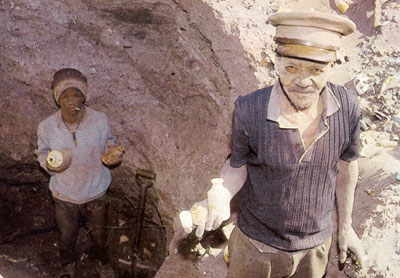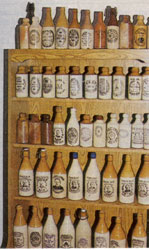TREVOR'S PLEASURE IS THE PITS
Every spare minute he has, under a blistering sun or in the freezing cold, Trevor Dally spends digging into the dusty grey horror of Kimberley's old rubbish dump - for to him it's a storehouse of historic treasures
by Rodney Bolam (Personality, March 7, 1988)

Trevor Dally flings another shovelful of ash from the pit he is digging into the old Kimberley rubbish dump. A serious collector, he's scornful of the "amateurs" who just scratch the surface in search of relics of the historic city's past.
N Kimberley, in mid-summer, teenagers sometimes break an egg on the bonnet of a car and watch it cook. They've done the same thing on the tarred roads with similar effects. It gets that hot. And in winter, as in all arid regions, the temperature plummets to below freezing at night. The mornings are bitterly cold and the children who ride to school on bicycles stop along the way to warm their hands inside their blazers.
It's a harsh world. But nothing can be more desolate than Trevor Dally's stamping ground. He spends just about every
spare moment he has on the old rubbish dumps north east of the city.
Trevor works for Eskom and his job takes him over the barren areas of the Northern Cape and sometimes into South West Africa, tracing the routes the great powerlines wild follow. He is 29, a bearded man, burned a dark ochre by the sun. Sometimes he is away from home for weeks at a time, but when he returns and drops his washing off at his mother's home in Transvaal Road; his thoughts are already on the dump - his treasure trove.
It looks like a moonscape. There is no vegetation on it. It consists of a series of mounds and hillocks. It is grey and char-coal grey - and dotted with holes dug into it by people like Trevor, delvers into the past.
"No one knows when it was opened by the Kimberley municipality, but it must have been before the turn of the century," says Trevor. "And what we have taken from it indicates that it was closed about i920." Trevor started digging in the dump about three years ago, before it became a popular site for collectors and casual visitors.
Even now, well known as it is, the heat and wind frighten most people off it. And the municipality has introduced a permit system to tighten control over its exploitation. A year's permit costs R100, casual visitors pay R10 for a licence which al-lows them to dig for three consecutive days. And no mechanical equipment is allowed which means that in spite of the number of people who visit the dump, some from the Transvaal and the western Cape, it will be many years before the 20-hectare site is denuded of its treasures.
Trevor is scornful of the "amateurs" who arrive in the hope of uncovering something of value. "Most can't take the heat and only scratch around on the surface," he says. "The good stuff is deep - a few metres down. So they're just wasting their time and messing up the site."
In summer, on weekends or when he's on leave, Trevor leaves home for the dump as early as possible in the morning. That could be at 4 am.
"The earlier I can get there, the more I can get done before it gets really hot," he says. I accompany him on one such morning. Dressed in heavy boots, old denim jeans and a T-shirt, he throws a flat garden spade and a garden fork into the back of his MGB sports car and heads for the dump. Another essential part of his equipment is a two-litre bottle of water.
The early morning air is warm and comfortable. Trevor removes his gear and strides towards a site he has already picked out. It is close to where he made a valuable find a few days before and he hopes to repeat his success. He wastes no time. The first spadesful of grey ash are soon falling in a pile around him.
"The dumps must have burned for years," he says. "Most of the stuff we re-move is dust. It is very fine and gets into everything, inside your clothes and even into your boots, no matter how tightly you tie them."
Sometimes he digs straight down, apparently unworried that he might be missing something worth keeping. But after a time it becomes obvious that he is studying the soil very carefully before pushing his spade into it. He digs deeper. Now the pit is waist-deep. He pushes his spade into the ash and stops. He crouches and works the ash and stone loose with his hands. He pulls loose a bottle.
It is a ritual he has repeated hundreds of times, but his excitement is palpable. He rubs the dirt from the bottle with his thick leather engineering gloves and holds it up. It has a strange shape: The
bottom is pointed rather than flattened and the glass is thick; the neck is welded on and a glass marble rattles inside. Trevor grins. He has many similar bottles, but few are unearthed in perfect condition.
"This is what makes the digging worth while," he says. "You never know what the next spadeful will uncover. It is very exciting."
After four hours Trevor has dug more than two metres down. The ash now covers his clothes and his hair and beard are thick with it. Everything is grey. Bottles line the rim of the pit. Most he won't even bother to take home with him; they will be left for the "scavengers" who arrive towards evenings to gather what the collectors have discarded.
Carefully placed next to his bottle of water is a porcelain doll's head. It is in remarkably good condition. He has also found a number of dolls' arms and legs. He has a friend who collects them and will keep them to swop with him for other things. Also next to the water-bottle is a ceramic ginger beer bottle. Trevor is especially pleased with this because it's what he collects.
Trevor is by no means the only person who's excavating the dump. Two other "treasure-hunters," their ash-covered faces providing graphic evidence of what diggers have to put up with, display the fruits of their day's work. |
The pit has neatly cut sides and from a few metres away Trevor is invisible. The
only indication that someone is on the dump is the ash being hurled from the hole. It is now noon, and blisteringly hot. Trevor climbs from the pit, using his spade as a step-ladder. He drinks deeply from the water-bottle and then lets the liquid cascade over his head and neck.
He then gets back into the pit and be-gins chipping into the base of the walls. Suddenly he lets out a whoop. He scrambles to the surface clutching a small, square, ceramic object in his right hand. It is an antique toothpaste jar, complete with lid.
He rubs the muck from the lid. The script is clearly visible. It says: "White Rose Paste. An elegant preparation for preserving and whitening the teeth. Purifying and perfuming the breath. Prepared by S. Maw, Sons and Sons, Aldersgate, London, England."
He grins again. It is not a particularly
rare toothpaste jar, but it is nevertheless a valuable find. In this plastic age it seems crazy that anyone could have thrown away something so beautiful.
Trevor makes one more trip into the pit, and he works faster now, digging deep at the base of the walls until they collapse with a whoooof of dust. His haul from this is a collection of "common" bottles and one thin, fragile-looking bottle with a long spiral neck. He will be keeping that one. It is a coconut-oil bottle.
Then it is time to leave the dump. He collects the items he intends taking home in plastic carry-bags, glances once at what was the hole he had dug, and sets off for the car.
Sometimes he stops off for a drink and a bite to eat at his parents' home before going on to his house to scrub away the dirt in the shower. Then he will put his day's finds in an acid bath to clean them as thoroughly as possible. Anything really worth while will go on to one of the shelves or cabinets against the walls of his lounge or dining-area. The rest he'll -put aside to swop with friends.
"Some people have been digging for 18 years in the Kimberley dumps. They have quite a lot more than me," he says. It seems difficult to believe for his home is packed with treasures from the dump.
He proudly shows me his collection of ginger beer bottles. The most sought after is the "big head" Sullivan's Ginger Beer bottle with a portrait of Cecil John Rhodes on it. Trevor has one of these. His big hope, though, is to finds a P. Paulse ginger beer bottle, of which he has only ever seen one.
Most of the ginger beer bottles were made in Edinburgh, Scotland, while Eng-land was the place of origin of most of the glass and earthenware containers. They were imported empty and then filled by local entrepreneurs. Apart from the bottles, the toothpaste, cold cream and ointment pot lids are also prized. Rarely found intact are earthenware foot-warmers and hot-water bottles
Dolls' heads, arms and legs - beautifully painted - are sought after by a particularly eager band of collectors. Most of the dolls imported in those days were made in Germany.
Other finds include clay pipes, cutlery
and crockery. Trevor has found great piles of broken plates discarded by the Kimberley Club. Perhaps Rhodes, Dr Jameson, or even Barney Barnato ate off
them.
"I have met a lot of interesting people on the dumps," says Trevor. "Sometimes I take a bit of leave and go and dig at `their' dumps in the Transvaal or in the Eastern Cape. We try and keep the location of the dumps secret because there are a lot of people who will just bash their way into the ground and smash more than they find. It is a waste and we don't want them around.
"I swop stuff with other collectors and if there is something I really like or need for my collection, I'll buy it. The price basically depend on how much the particular item is worth to the person who wants to buy it.
"I haven't put a price on my collection. I don't think of it in money terms. I enjoy it. That is why it is valuable to me. I don't dig to make money. I do it because it's exciting and because unearthing some-thing rare is so rewarding.
"Sometimes I'll dig for an entire day without finding anything worth while. Other days I'll end up with a number of important pieces. It's a chancy business. That's what makes it so fascinating."
Trevor picks up a bottle, scarred and discoloured by the fires which smouldered many decades ago on the Kimberley dump. He rubs the glass with a cal-loused thumb. For a moment the past glistens.
One of Trevor's many finds was this near perfect earthenware foot warmer. The ceramic jars behind him nearly all came from the Kimberley dump. |
Trevor's display of ginger and herb beer bottles include a rare one on which the name "Beaconsfield" is spelled "Beaconseitld." |


